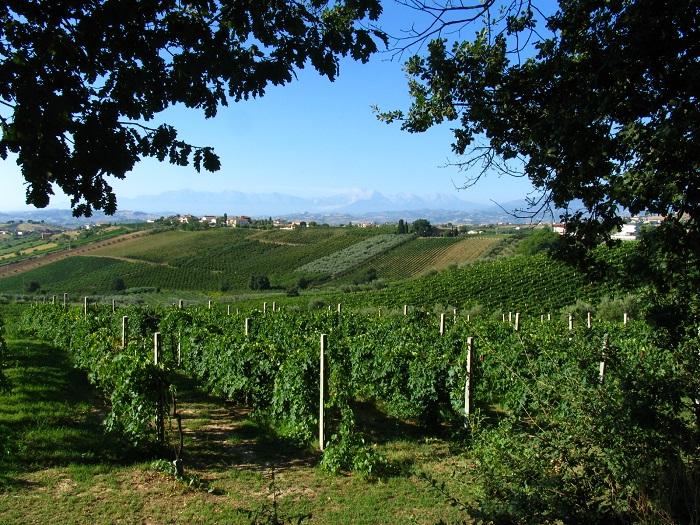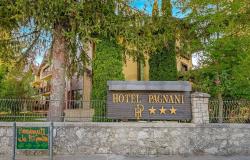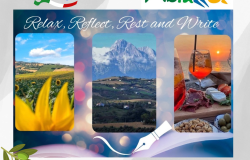ARNEIS
HISTORY: The overwhelming agreement amongst historians is that the first mentions of the white Arneis grape surfaced in the 15th century. Some suggest that this grape was first seen in the Torino village of Chieri (described as the Ranaysii grape) in 1432, while another notable nod came in 1478 with the mention of the Reneysium grape in Canale.
The name it's known by today is said to have first been documented by ampelographer Count Giuseppe di Rovasenda, who wrote of the grape and its appearance in Piedmont in 1877.
LOCATION: Primarily in Piedmont, in the hills of the Roero. Also to be found in limited quantities in Liguria and Sardinia. Outside of Italy, the Arneis grape is grown in countries such as the USA, Australia and New Zealand.
PROPERTIES: Wines containing Arneis grapes can be full bodied with a notable floral taste. The unoaked Arneis has a more notable aroma, although the oaked version is more full bodied. There are hints of almonds, pears and peaches in the aroma.
GROWTH AWARENESS: Owing to low acidity and the risk of over-ripening in the months after September, then Arneis grape can be tricky to cultivate. The Arneis vine can run the risk of falling foul of mildew powder, although there have been recent developments in cloning which have resulted in grapes that can resist this problem. There is also the potential issue of oxidisation which can have an adverse effect on the taste.
SUMMARY: The Arneis grape is something of an unassuming presence in the wine community. There's something of the outsider about the Arneis – for example, Arneis grapes have been planted alongside Nebbiolo grapes to attract the attention of birds who would be drawn to the sweet Arneis smell and thus, keep away from the Nebbiolo grapes which are deemed to have greater value.
Traditionally, the Arneis grape is used regularly as a blending agent for other wines. It can soften other grapes' tannins and powerful properties (eg: the Nebbiolo grape).
The Arneis grape experienced a notable blip last century. Owing to issues such as oxidisation, the first part of the 20th century saw a decline in Arneis growth – but it experienced a renaissance later on as winemakers used different soils to give the grapes better structure and more acidity (eg: sandy clay soil). Today, the Arneis has prospered to the point where it's no longer hiding in the shadow of Nebbiolo. In addition to being a blending grape, it's also an enjoyable wine in its own right.
PECORINO
HISTORY: Not a bedfellow of Pecorino cheese, but said to take its name from the little sheep (pecora) who would be partial to the grapes in the Marche while moving through the area's vineyards.
The white Pecorino grape is said to have started life as a wild vine which was cultivated in the Sibillini Mountains.
LOCATION: The Marche (its native home) as well as regions such as Umbria, Lazio and Liguria.
PROPERTIES: This straw yellow coloured grape has high levels of acidity and sugar. The end result is a fine balance – while the sugar makes for a reasonably high alcohol content, the acidity tempers this with a fresh, crisp taste. It has a bouquet of jasmine and acacia with a tinge of licorice coming through.
GROWTH AWARENESS: The Pecorino grape can produce low yields (owing to its early ripening qualities). It can however have a strong resistance to downy and powdery mildew.
SUMMARY: Like the Arneis grape, the Pecorino grape also experienced a downturn in the middle of the 20th century. This was on account of its low yielding properties, which enabled other grapes to take over. However, around the 1980s, the Pecorino grape was rediscovered as part of a batch of lesser known wines. By the 1990s, Pecorino grapes were prepared for wine consumption, and since then, its status has risen again.
TREBBIANO
HISTORY: This grape is said to date back all the way to the Roman era. During the 14th century, it was a popular grape in France after the Papal Court transferred from Rome to Avignon.
LOCATION: Particularly popular Trebbiano wines include Trebbiano d'Abruzzo (said to be the white wine version of the red Montepulciano d'Abruzzo) and the blended Orvieto white wine of Umbria. It's also to be found in the Tuscany region. It's a popular grape across the globe, including countries such as Argentina, France, Spain and Bulgaria.
PROPERTIES: The Trebbiano grapes can produce wines that are crisp, light and refreshing. They are low in sugar and high in acidity.
GROWTH AWARENESS: The popularity of the Trebbiano grape is due in part to its high yielding qualities, although a drawback is its limited shelf life. It has a strong resistance to potential disease.
SUMMARY: The Trebbiano grape makes for a light, fruity and highly enjoyable wine. It is also a popular element of Cognac, Armagnac and also Balsamic Vinegar. Altogether, its high yielding properties and popularity not just in Italy, but all over the world, make the Trebbiano grape one of the most popular types.
DOLCETTO
HISTORY: There are various historical theories as to where this black Italian grape came from. One school of thought suggests that the wine comes from a village called Doglioni in Piedmont, while another theorises that it came to Monferrato from France in the 11th century.
The history books claim that Dolcetto wine was a favourite of the Arboreo family of Valenza while King George II of England received it as a present from Barnaba Centurione in 1700.
The name of the grape translates as “little sweet one”.
LOCATION: Mainly to be found in the Piedmont region, the Dolcetto grape is also a popular presence in Ovada, Alba and Liguria. Overseas, the Dolcetto grape has been a popular mainstay in countries such as America (most notably in California) and Australia (where Dolcetto vines are said to date back all the way to the 19th century).
PROPERTIES: Dolcetto grapes contain low to medium levels of acidity, and offer a fruity, tannic taste. The tannic aspect of the Dolcetto grape means that it can leave an almond-like aftertaste. The over-riding flavours are those of licorice, black cherry and a hint of prune.
GROWTH AWARENESS: A benefit of the Dolcetto grape is that it's simple to grow. Because of its high levels of anthocyanins in the purple skin, maceration time of Dolcetto is relatively short. A short fermentation period can also prevent an over-abundance of tannins. Dolcetto grapes are commonly grown in cooler vineyard areas as this ensures that they keep their acidity and do not ripen prematurely.
SUMMARY: Dolcetto grapes are hugely popular – both with wine connoisseurs and with vintners. The fact that Dolcetto wine can be sold within a matter of months after harvest means a good, steady cashflow for winemakers. This is particularly useful in Winter while other grapes are being prepared (eg: Nebbiolo). Wines made with Dolcetto grapes make for a tasty experience with its subtle, spicy smell and pleasant, licorice and cherry-infused flavours.
NEBBIOLO
HISTORY: The first hint of the Nebbiolo grape goes way back in time to the 1st century days as Pliny The Elder muses on the wine found in the Pollenzo region. The name of the grape isn't directly alluded to, but its description is said to fit the bill.
If it's a name you want, then travel forwards in time to 1268 when a nibiol wine is described in the Rivoli region. At the turn of the 14th century, further accounts are made about this grape variety – one from a Roero producer who possesses a barrel of Nebbiolo, the other from jurist Pietro Crescenzi, who wrote of his appreciation in the treatise Liber Ruralium Commodorum.
Nebbiolo appreciation was also rife in La Morra to the point where, centuries ago, shearing a Nebbiolo vine was highly illegal. The punishment for such wrong doings was a fine, or in extreme cases severance of the right hand or even hanging.
The name is said to come from the Italian for fog, nebbia – either in accordance with the foggy October conditions in the Langhe (the location of many Nebbiolo vineyards) or the foggy veil that appears on maturing Nebbiolo grapes. An alternative source of the origin of the name is said to be from the Italian for noble, nobile.
LOCATION: The Piedmont region, primarily. Various Lombardy regions (eg: Franciacorta). America, Australia and Argentina commonly favour Nebbiolo overseas.
PROPERTIES: Aromas of cherries, prunes, raspberries and even violets and roses. High levels of tannin and acidity present.
GROWTH AWARENESS: Harvesting for Nebbiolo traditionally takes place in or around the month of October. A key factor of Nebbiolo cultivation is that the grape requires warm conditions in order to balance out the high acidity and tannin levels by developing the right amounts of sugar and flavour. With that in mind, Nebbiolo grapes are commonly grown on southern or south western facing slopes to ensure maximum opportunity for sunlight. Rainy days can have an adverse effect on the Nebbiolo grape – for example, the grape can shatter in wet conditions.
SUMMARY: When it comes to that common theory that a wine improves with age, Nebbiolo wines fit the bill. It is said that a period of up to 30 years can ensure the highest quality Nebbiolo wine, with a distinctive, appealing bouquet of roses, spices, dried fruits and fresh herbs. Nebbiolo grapes can also be blended with other types to add a bit of colour and also to temper tannin levels. It's received rightful applause and acclaim as a tasty, palatable wine grape that continues to endure and appeal.
BARBERA
HISTORY: Travelling back in time, the red Barbera grape is said to have first appeared in the Monferrato hills in central Piemonte in the 13th century. Between 1246 and 1277, The Cathedral of Casale Monferrato produced documents which mention leasing details of a vineyard containing Barbera grapes (named in the documents as de bonis vitibus bar bexinis).
LOCATION: Commonly found in Piemonte.
PROPERTIES: The Barbera grape contains high acid levels, mild tannins, and gives a strong, rich flavour and smell of black cherries and blackberries. Deep ruby in colour.
GROWTH AWARENESS: It's said that there are some vineyards that boast century-old Barbera vines for the full experience - strong flavour, extra tannins and powerful fruity aromas. The younger Barbera wines still afford fresh, fruity flavours and aromas.
Late September and early October is the key period for growing Barbera grapes. A benefit of the Barbera grape is that it results in high yield – although this needs to be kept in check in order to ensure that the quality isn't compromised.
Because of its high acid levels, Barbera grapes are blended with other grapes lower in content to produce a more balanced result.
In some cases, Barbera wine can be prepared using a process with toasted oak barrels. The heat from the flame can produce a rich, complex and vibrant oaky taste and aroma.
SUMMARY: The very popular Barbera wine is rich in character and strong in flavour and aroma. There is a wide range of Barbera wines that can suit all tastes from lighter, medium wines, abundant with crisp fruity flavour to the more intense, powerful, barrel-based offerings that are brimming with colour, density and a unique, oaky, spicy sensation all of its own.
SANGIOVESE
HISTORY: The name of Sangiovese comes from the Latin for “the blood of Jove”, which tallies with the assertion that an early instance of Sangiovese can be found in the Roman era.
The first written instance of Sangiovese grapes can be sourced from Ciriegiulo (Giovanvettorio Soderini)'s musings on this subject in 1590, noting both its benefits and the potential problem of mishandling (which could reduce the fruity wine taste into vinegar).
Other historical writers have argued that Sangiovese grapes work best when blended with other grapes. Cosimo Trinci and Giovanni Cosimo Villifranchi both asserted that this type of grape was at its best when mixed with other types but alone, it was too strong and acidic.
LOCATION: The majority of Central Italy regions including Sicily, Lazio and Romagna.
PROPERTIES: Earthy, powerful aromas and the taste of sour red cherries – although younger grapes can take on a lighter, strawberry-based flavour with an undercurrent of spice – it's recommended that Sangiovese wines are consumed early on in their lifespan, although a common solution to combating the grape's high acid content and light body is to blend with other grape varieties to ensure a well-rounded and palatable drink.
GROWTH AWARENESS: The harvesting season for Sangiovese grapes takes place between late September and early to mid October. The vines need good amounts of sun and warmth but too much can affect the flavour of the grapes. The vines can manage periods of drought, but owing to the thin skin of the grape, rain can potentially lead to rot. This is another grape that can result in a high yield quotient, so again, this prolific example needs to be kept under control in order to avoid over production and lower quality.
SUMMARY: The Sangiovese grape is a good blending grape which avoids the pitfalls of high acidity and too much power when mixed with other varieties. Sangiovese grapes can offer unique tastes, aromas and also individual characteristics in accordance with the region they come from – whether it's the herbal-enhanced Tuscan grape or the fruity flavours from California. Strong tastes and flavours combine with great adaptability to form a red wine grape that will always stand the test of time.
PINOT GRIGIO
HISTORY: Pinot Grigio is the Italian version of the popular Pinot Gris grape which has been in existence since the Middle Ages. Back in the day, it was originally known as Fromenteau.
LOCATION: The Pinot Grigio grape is commonly harvested in areas such as Lombardy, Trentino, and Venezia. Outside of Italy, Pinot Grigio wines are popular in America, Australia and also Britain.
PROPERTIES: Although a clone of Pinot Gris, the Pinot Grigio grape offers a more subtle but very tasty wine with a crisp, light and very appealing flavour. It contains light fruity aromas of lemon and apple with a hint of blossom and is low in acidity.
GROWTH AWARENESS: Because of its low acid content, the Pinot Grigio grape is harvested at a reasonably early stage in order to keep as much acidity as possible. To prepare for its crispness and freshness, a common fermentation process is to use stainless steel containers as opposed to barrels, in order to eschew a stronger, oaky taste and aroma.
SUMMARY: With Summer looming, there's never a better time to enjoy a good glass of Pinot Grigio. It may not be the strongest wine grape, but a Pinot Grigio wine is the perfect accompaniment to a good meal or picnic on a hot Summer's day. Fruity and fresh in appearance and taste, it's little wonder that the Pinot Grigio grape is a massively popular choice all over the world.








